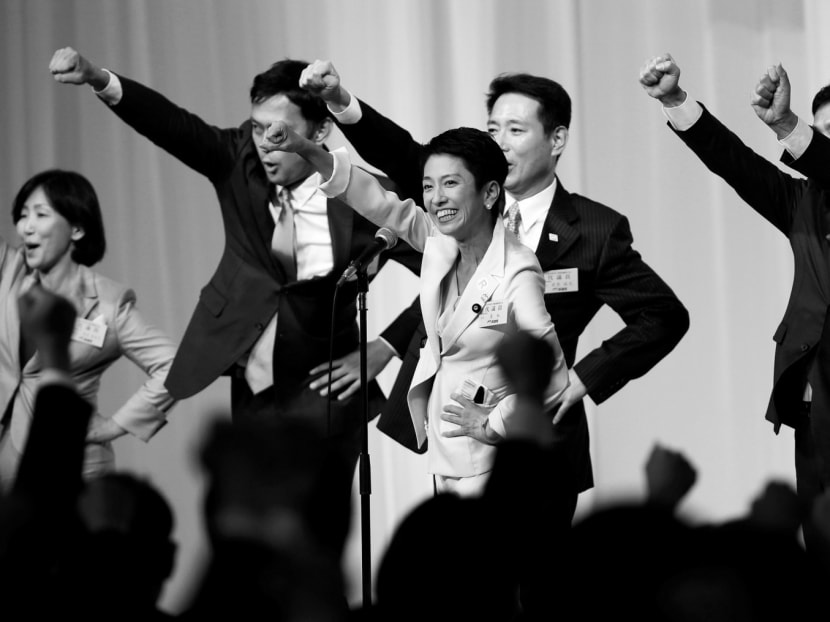Japan’s new icon for gender equality
Japanese women are making cracks in the glass ceiling of politics. Last month, Japan’s main opposition party, the Democratic Party (DP), elected a woman as its new leader. In light of the dearth of women in politics and leadership positions in all sectors of Japanese society, this is a significant development.
Japanese women are making cracks in the glass ceiling of politics. Last month, Japan’s main opposition party, the Democratic Party (DP), elected a woman as its new leader. In light of the dearth of women in politics and leadership positions in all sectors of Japanese society, this is a significant development.
Going only by her first name, Ms Renho has been a member of the Upper House of the Diet for the past 12 years, before which she was a newsreader. She has captured the attention of the Japanese public with her charismatic personality, charming good looks and powerful oratory skills. She has also sparked intrigue by becoming not only the first female leader of the DP, but also the first political leader with dual nationality.
Ms Renho was born in Japan to a Taiwanese father and a Japanese mother, and held dual nationality until very recently.
Due to pressure from the right-wing press, she was compelled to renounce her dual citizenship. Despite hundreds of thousands of Japanese estimated to also hold dual citizenship and there being no penalties for this, holding a second passport is illegal in Japan.
Her rise to power is significant for women, who currently hold only 12 per cent of seats in Japan’s legislature and 9 per cent in the Lower House. But while having a female leader is a first for the DP, it is not a first for the Japanese opposition as a whole.
Ms Takako Doi headed the Japan Socialist Party (JSP) when it was previously the main political opposition. Ms Doi served as party leader from 1986 to 1991 and again from 1996 to 2003, and was also the first female speaker of the Lower House. In 2000 another woman, Ms Fukushima Mizuho, replaced Ms Doi and led the socialists until 2013.
The JSP (now called the Social Democratic Party) began to lose popularity in the late 1990s and became a minority party. The predecessor of the DP, the Democratic Party of Japan (DPJ), became the primary opposition party and eventually won control of the government in 2009, and was the ruling party when the triple disaster occurred in Fukushima in 2011.
The party was generally perceived as being ineffective in the crisis and voters made their disappointment known in the 2012 election, when the Liberal Democratic Party (LDP) regained control of the government. This result was widely understood as a vote against the DPJ rather than strong support for the LDP, which means Ms Renho has her work cut out for her to restore the public’s faith in her party.
Nominating women to positions of power, or simply running them in certain seats, has long been a strategy to improve a political party’s image in times of crisis. But such a move can been interpreted as largely tokenistic.
In 1989, when the Japan Socialist Party nominated a large cohort of women — quickly labelled the “Madonna boom” by the media — there were certainly elements of tokenism. This was evidenced by the fact that many of the women were wives of unionists or daughters of former ministers and had minimal experience in electoral politics outside support roles. And in 2005 and 2009, the LDP and the DPJ saw a record number of women elected to the Lower House as a result of strategies to inject new blood into the party to project an image of “change”.
Many of the women elected did not survive past their first term because they lacked experience and political support. The recent visibility of women in power in contemporary Japanese politics suggests that the appointment of Ms Renho is much more than a token gesture by the DP to appeal to voters. Now that there is a cohort of experienced women within the system, women can reach positions of power and avoid being labelled tokenistic.
Ms Renho’s rise to the top is the third instance this year of women reaching top positions in Japanese politics. The other two are Ms Tomomi Inada, who was appointed by Prime Minister Abe to the position of Defence Minister, and Ms Yuriko Koike, who was elected the new Governor of Tokyo.
More women in positions of power is certainly symbolically important for females who are confronted with a sea of men in suits when tuning in to political news. But whether women in power implement policies that benefit women is an equally important question.
Ms Renho campaigned on a platform of greater investment in people and education — this included promises of free preschool education and increasing the salaries of childcare workers. But unless the DP has the reins of power, Ms Renho might find it difficult to prove her worth in the eyes of women.
Her greatest challenge will be restoring the DP so that it becomes a serious and electable alternative to the LDP by the next general election due before 2018. EAST ASIA FORUM
ABOUT THE AUTHOR:
Emma Dalton is a lecturer in Japanese at the Department of Languages and Linguistics, La Trobe University.







